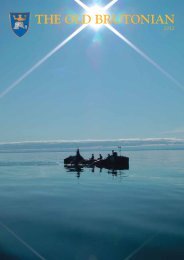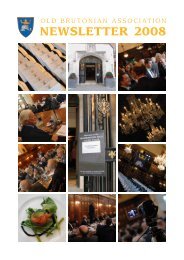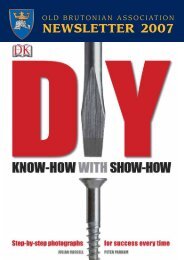Download PDF - Old Brutonian Association
Download PDF - Old Brutonian Association
Download PDF - Old Brutonian Association
You also want an ePaper? Increase the reach of your titles
YUMPU automatically turns print PDFs into web optimized ePapers that Google loves.
NEWS OF OLD BRUTONIANS<br />
flying bombers to cut the wires of barrage balloons. To<br />
obtain data, Wilson had to make a series of flights in a<br />
specially modified Hurricane, a task which involved flying<br />
the aircraft into the wires of tethered balloons. On one<br />
occasion the wire jammed his controls, and he had great<br />
difficulty extracting the aircraft from a spin. He recovered<br />
at 1,000 ft and landed with a length of wire trailing<br />
behind his aircraft.<br />
On November 30th 1942, he took off from Exeter<br />
airfield in his Hurricane for a further test. As a special<br />
precaution, his cockpit was reinforced to reduce the risk<br />
of decapitation, but the heavy structure gave him a very<br />
limited view. He did not see two German fighters, which<br />
were on a tip-and-run raid over Devon. Their Cannon<br />
shells thudded into the Hurricane, severely damaging the<br />
aircraft’s controls. Wilson tried to bale out but could not<br />
open the heavy canopy; after several attempts, he<br />
managed to land, then discovered that most of the rear of<br />
the aircraft had been shot away.<br />
Early models of the four-engine Halifax bomber<br />
suffered control problems resulting in many accidents<br />
with heavy loss of life. A test crew from Farnborough,<br />
endeavouring to identify the problem, were killed when<br />
the aircraft crashed out of control. Immediately<br />
afterwards, Wilson took an engineer on a test flight for a<br />
further attempt to obtain data. As the heavy bomber<br />
entered a turn, it rolled violently and entered a vertical<br />
dive. With great difficulty, Wilson managed to regain<br />
control before landing the aircraft safely. A major<br />
modification to the aircraft’s two fins eventually solved<br />
the problem. Wilson was awarded the AFC.<br />
After spending six months briefing pilots in the United<br />
States on RAF flight testing methods, Wilson was given<br />
command of No. 102 squadron, equipped with modified<br />
Halifax bombers, and led his squadron on many raids<br />
over Germany.<br />
On four separate occasions his aircraft was damaged<br />
by anti-aircraft fire. While leading a raid to Scholven in<br />
October 1944, his aircraft was badly damaged as he<br />
started his bombing run. Despite this, he continued to fly<br />
straight and level over the target until the bombs had<br />
been dropped. The citation for his DSO described him as<br />
“a squadron commander of outstanding quality,<br />
possessing a high order of courage and devotion to duty.”<br />
Wilson was deeply affected by the loss of his young<br />
crews. He insisted on writing personal letters to the next<br />
of kin of all the aircrew posted missing, often remaining<br />
at his desk for hours after he had returned from an<br />
operation.<br />
After the war, he had appointments in Iraq and the Far<br />
East, and commanded Nos. 9 and 49 squadrons when<br />
they were converting from the Lancaster to the Lincoln<br />
bomber.<br />
After a series of appointments at the Air Ministry,<br />
Wilson served in Germany before flying fighters as the<br />
chief instructor at the Central Gunnery School and taking<br />
a two-year appointment on the operations staff of the<br />
Second Allied Tactical Air Force in Germany.<br />
He retired in 1959, when he joined the export<br />
department of the aero-engine division of Rolls-Royce. He<br />
finally retired to Hampshire in 1973.<br />
Douglas Wilson, who died on June 6th, married Valerie<br />
Roche in 1940. The marriage was dissolved in 1953, and in<br />
the same year he married Eileen Farrell. He is survived by<br />
his second wife and by twin daughters and a son from<br />
his first marriage.<br />
(Reproduced from The Daily Telegraph of June 30th, 2004.)<br />
JAMES SOMERVILLE (O40/45)<br />
Alderman James Somerville died on January 21st, 2005.<br />
The funeral service was private but a memorial service<br />
took place in the church at Kemble on Friday, February<br />
4th with Royal British Legion representatives present.<br />
James was in Plox from 1935 and then in <strong>Old</strong> House<br />
between 1940 and 1945 when he joined the Royal<br />
Marines, being demobbed in 1948. Until 1974 he was a tea<br />
planter, after which he devoted much time to the Royal<br />
British Legion as Housing Manager and area organiser. He<br />
worked tirelessly as a district councillor for the<br />
Thameside District and was made an alderman after<br />
twenty years service.<br />
MARK PRIDIE (O55/59)<br />
Mark Pridie died on July 21st, 2004 on his yacht,<br />
Contessa in Cape Cod, Massachusetts. Mark and his wife,<br />
Mandy, were on holiday, enjoying his retirement from the<br />
Merchant Navy. He died peacefully after a swim in the<br />
ocean. Mark was an easy-going person with many friends<br />
in the yachting world. He leaves behind not only his<br />
widow, Mandy, but also two sisters and four brothers. He<br />
was cremated on July 29th last year in Bourne, Cape Cod.<br />
A service of thanksgiving, conducted by Mark’s youngest<br />
brother, the Revd William Pridie, took place in the church<br />
at Northlew, near Oakhampton, Devon on August 26th,<br />
2004.<br />
MEMORIAL RUGBY MATCH<br />
On 7th November, 2004, one year after the tragic loss<br />
of Alex, it was fitting for family and friends to come<br />
together to remember, enjoy a good game of rugby and<br />
enjoy some good food afterwards. For some, it was the<br />
first game in about seven years, since the days of Mr<br />
Passmore’s Set Six; for others, it had been less than a<br />
term, and it showed.<br />
The teams arrived – some members a little hung over<br />
from the night before in The Blue Ball and some even<br />
needing their boots put on for them! A mixture of<br />
members of Staff and OB’s drawn from a wide range of<br />
year groups donned their rugby kit to do battle on Hyde<br />
playing field. It was great to see current members of the<br />
School alongside the pitch, supporting the teams. It was<br />
very kind of the new Headmaster, Mr Lashbrook, to let us<br />
use the pitches and even to give up a bit of his weekend<br />
32 OLD BRUTONIAN ASSOCIATION NEWSLETTER 2005










